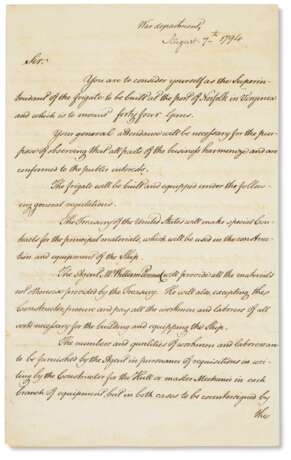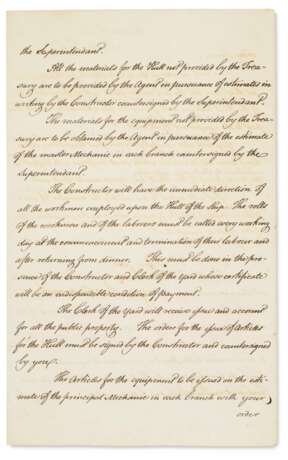ID 627681
Lot 191 | The Birth of the U.S. Navy
Estimate value
$ 10 000 – 15 000
Three pages in two bifolia, 322 x 198mm. (Mild ink transfer from adjacent pages, a mild crease to the final page.)
The birth of the U.S. Navy: the orders to build the U.S.S. Chesapeake at Norfolk. A fine piece of naval history concerning a highly important vessel. Secretary of War Knox passes on detailed orders to Dale to serve "as the Superintendent of the frigate [the Chesapeake] to be built at the port of Norfolk in Virginia and which is to mount forty-four guns. Your general attendance will be necessary for the purpose of observing that all parts of the business harmonize and are conformed to the public interests." Knox goes on to explain that the Treasury Department will make contracts for the basic materials, while an agent, "Mr. William Pennock will provide all the materials not otherwise provided by the Treasury." He would be responsible for hiring and paying all the necessary "workmen and laborers." Dale was to make weekly reports on "the number of workmen employed and the progress made in the execution either of the Hull or equipment."
On 27 March 1794 Congress passed an Act to Provide for Naval Armament in response attacks in the Mediterranean by the North African corsairs, which authorized the construction of six frigates. No Navy Department existed at this date so Knox handled these orders. And as there was no government Navy yard established, the work for this frigate had to be contracted to private shipbuilders. The government wanted to spread the economic benefit to different regions, so the six frigates were built at six different shipyards: the United States at Philadelphia, the Constitution at Boston, the President in New York, the Congress at Portsmouth, New Hampshire, the Constellation at Baltimore and Dale's ship, the ill-fated Chesapeake, at Norfolk. Work stopped on the ships when peace terms were reached in 1796. But with the threat of war with France in 1798, work resumed and the Chesapeake was launched in 1799. She saw action during the quasi-war and against the Barbary states under Jefferson. She was at the center of a national scandal when captain James Barron allowed her to be blasted and boarded by the British Leopard in 1807. Stephen Decatur replaced Barron as captain (the two would fight a duel in 1820, which left Barron dead). The HMS Shannon captured the Chesapeake (now under Samuel Evans) on 1 June 1813, killing 146 of her crew in the process. She spent the last four years of her life in the British fleet, and her timbers were sold to build houses in Britain in 1816.
| Artist: | William Shakespeare (1564 - 1616) |
|---|---|
| Applied technique: | Pencil |
| Artist: | William Shakespeare (1564 - 1616) |
|---|---|
| Applied technique: | Pencil |
| Address of auction |
CHRISTIE'S 8 King Street, St. James's SW1Y 6QT London United Kingdom | |
|---|---|---|
| Preview |
| |
| Phone | +44 (0)20 7839 9060 | |
| Buyer Premium | see on Website | |
| Conditions of purchase | Conditions of purchase |














